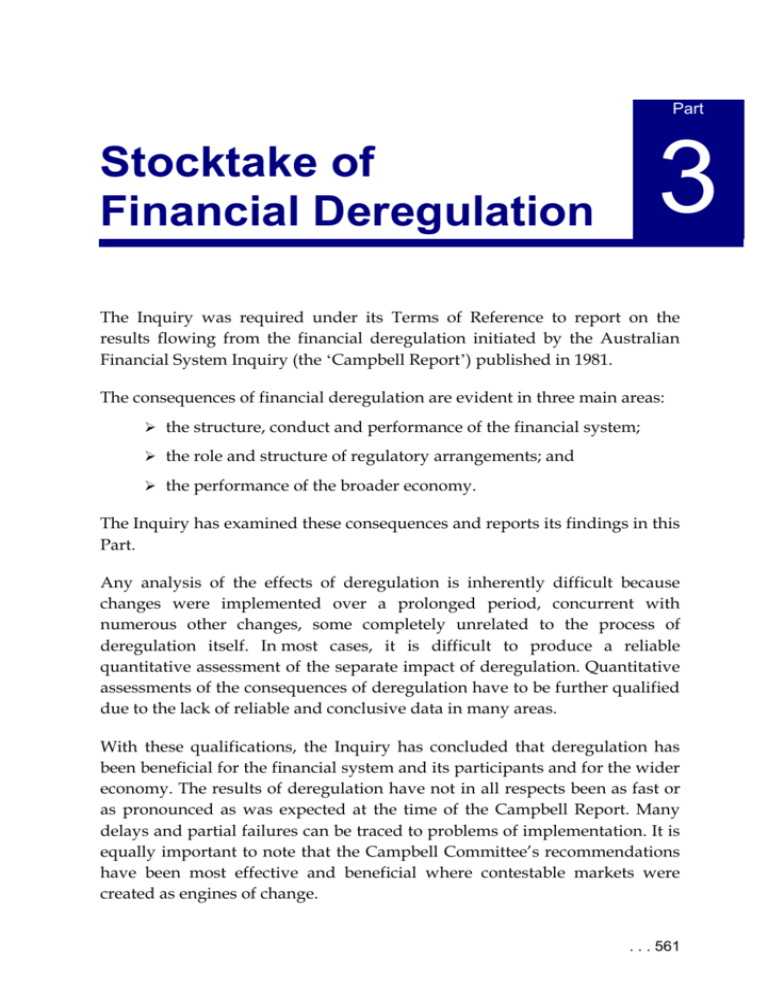Stocktake of Financial Deregulation
advertisement

Part 3 Stocktake of Financial Deregulation The Inquiry was required under its Terms of Reference to report on the results flowing from the financial deregulation initiated by the Australian Financial System Inquiry (the ‘Campbell Report’) published in 1981. The consequences of financial deregulation are evident in three main areas: the structure, conduct and performance of the financial system; the role and structure of regulatory arrangements; and the performance of the broader economy. The Inquiry has examined these consequences and reports its findings in this Part. Any analysis of the effects of deregulation is inherently difficult because changes were implemented over a prolonged period, concurrent with numerous other changes, some completely unrelated to the process of deregulation itself. In most cases, it is difficult to produce a reliable quantitative assessment of the separate impact of deregulation. Quantitative assessments of the consequences of deregulation have to be further qualified due to the lack of reliable and conclusive data in many areas. With these qualifications, the Inquiry has concluded that deregulation has been beneficial for the financial system and its participants and for the wider economy. The results of deregulation have not in all respects been as fast or as pronounced as was expected at the time of the Campbell Report. Many delays and partial failures can be traced to problems of implementation. It is equally important to note that the Campbell Committee’s recommendations have been most effective and beneficial where contestable markets were created as engines of change. . . . 561 Part 3: Stocktake of Financial Deregulation Chapter 14 provides a broad historical survey of regulatory change in the finance sector. Chapter 15 describes the main consequences of deregulation for the structure, conduct and performance of the financial system. Chapter 16 assesses the consequences of deregulation and subsequent changes in the financial system for the development of financial regulation. The effects of deregulation on the wider economy are analysed in Chapter 17. The key findings are summarised in the remainder of this overview. The Financial System (Chapter 15) The Campbell Committee’s recommendations were aimed at enhancing Australia’s financial system in a number of areas: competition; efficiency; as a result of the above, international competitiveness; and choice and quality of financial products. Most of these objectives were achieved to some extent, albeit not always to the full extent expected, and often assisted by parallel developments. Applying the contestability of markets and the intensity of pressures on price and profitability as proxies, it appears that competition in Australia’s financial system has become more intense since deregulation in many areas. However, this increase has not been uniform across all market segments: areas such as home lending or corporate finance have been under more pressure than transaction accounts or retail deposit taking. All three aspects of efficiency (allocative, technical and dynamic) in Australia’s financial system have improved since deregulation. Many types of transaction costs have fallen while transaction volumes have grown significantly, indicating that the financial system’s allocative efficiency (ie the ability of our economic system to direct resources to the areas of highest productivity) may have improved. Operating expenses have fallen in many areas, and overall productivity in the finance sector has improved. 562 . . . Part 3: Stocktake of Financial Deregulation Dynamic efficiency (the speed of adoption of innovations) appears to have accelerated as well. Deregulation has facilitated some improvement in the international competitiveness of Australia’s financial system. Trade in financial services (other than insurance) has turned from a deficit prior to deregulation to a surplus, which can be taken as prima facie evidence of improved competitiveness. Despite this improvement, regulatory constraints (such as the heavy reliance on transaction taxes, and onerous regulation of corporations fundraising) continue to limit the attractiveness of Australia as a financial centre, and restrict export growth in an increasingly global environment. More intense competition, improved efficiency and enhanced international competitiveness, as well as developments in technology and other forces for change, have led to a wider choice and improved quality of financial products. Improvements can be found in all functions of the financial system, but are most pronounced in the areas which have been under most intense competition. With widening of choice, information has become an even more critical resource to facilitate informed decision making by consumers. While there is substantially more information available to consumers today than prior to deregulation, the quality of this information, particularly in the area of financial advice, appears to be in need of further improvement. Financial Regulation (Chapter 16) Through its impact on the structure and conduct of the financial system, the deregulation which followed the Campbell Report had a consequential impact on the role, structure and cost of regulatory arrangements themselves. Four developments stand out: the enhancement of prudential regulation; the increased focus on consumer protection; efforts to harmonise regulation internationally; and increased focus on the contestability of financial markets. . . . 563 Part 3: Stocktake of Financial Deregulation The removal of controls on bank lending, and the problems experienced as a result, led to stricter prudential standards which were enforced through tighter capital requirements, a refocusing of regulatory agencies on prudential issues and better coordination of agencies. The widened choice of products and suppliers triggered by deregulation and other developments (such as falling lending standards or the emergence of unregulated participants) resulted in the need for enhanced consumer protection regulation. Four developments stand out: the growth in regulation governing the provision of credit (in particular the Uniform Consumer Credit Code); the development of disclosure regulation for banking and insurance-style products; the creation of alternative dispute resolution schemes; and the tightening of financial markets regulation. The increasingly global focus of suppliers and customers of financial services, as well as the global integration of economies, led to the emergence of international bodies and agreements aimed at harmonising financial system regulation. The importance of contestable markets as the key driver of improvements to the financial system has become apparent throughout the period of deregulation. Governments have responded by giving more attention to competition policy and reducing their own commercial activities in the financial system where such activities were perceived to distort market forces. These enhancements to the regulation of the financial system have not been without cost in particular, the compliance costs imposed on Australian financial institutions appear high by international comparisons. The Economy (Chapter 17) The qualifications about difficulty of analysis and inconclusive data apply particularly to assessing whether financial deregulation has benefited Australia’s overall economic performance. 564 . . . Part 3: Stocktake of Financial Deregulation It is clear that monetary policy has become more effective in the way intended when governments here and overseas embarked on financial deregulation. This has probably contributed substantially to macroeconomic performance and economic growth. Beyond this, the conclusions which can be drawn are inferential: the freeing of formerly controlled interest rates should have led to a better allocation of resources, which should in turn have led to a more productive economy; the removal of credit rationing in the banking sector should have led to more efficient financing and pricing of production; freeing of inward and outward capital flows should have increased the efficiency of investment in Australian industry and the efficiency of investment of Australian capital; and as one of a set of changes which helped expose Australian industry to greater international pressure, financial deregulation should have encouraged reforms in the real economy. While most of these positive outcomes appear to have occurred in Australia, it is also evident that many mistakes some of them costly were made in the early years of a deregulated financial system. During the 1990s, the expected gains from improvements in allocative efficiency may have emerged more clearly. They are likely to predominate in the future. Obviously, although deregulation may have made some contribution to Australia’s macroeconomic problems since the early 1980s, these problems cannot be attributed directly to deregulation. In particular, the persistent problems of high unemployment and low national savings are not closely bound up with financial deregulation. The Inquiry concludes that Australia’s economic structure in the 1990s shows signs of being more competitive, more flexible and more capable of coping with the pressures of the current decade than would have been the case without financial deregulation. . . . 565









